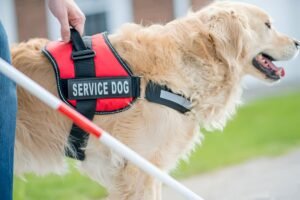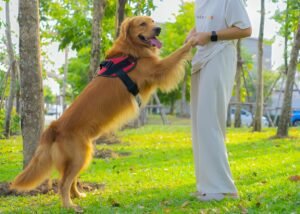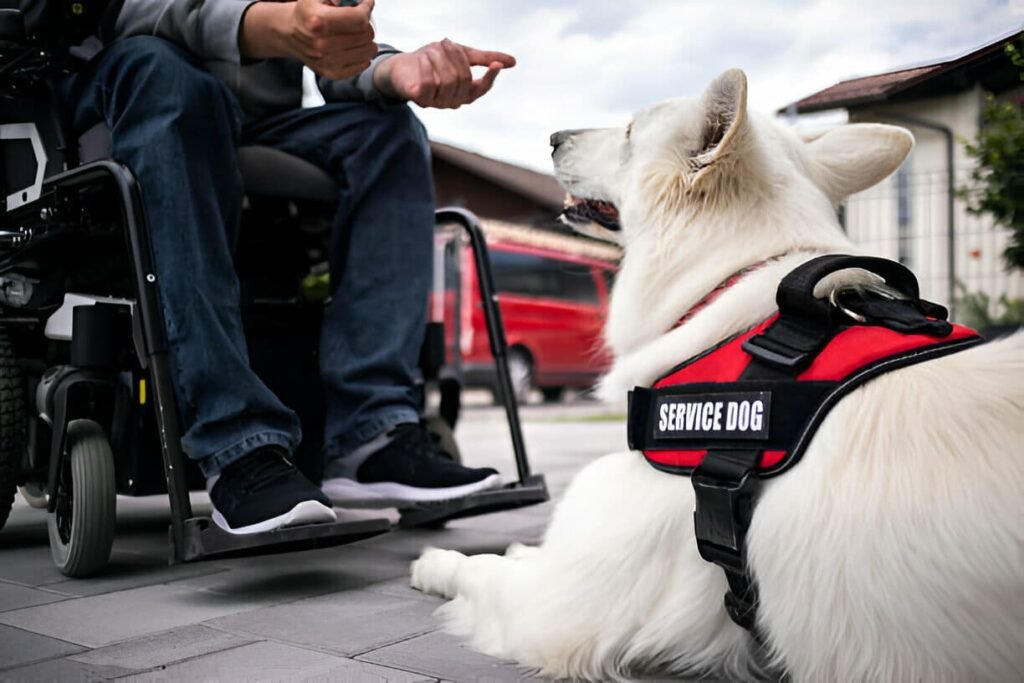Do you have aspirations of training your devoted dog to be a service dog so that it can help someone in need? The process of how to train your dog to be a service dog is significant and gratifying. We’ll go over each step of the process of training a service dog in this in-depth guide. From figuring out whether your dog is legal to training techniques and even controlling public access, we can assist with it all. Here’s a guide on how to train your dog to be a service dog.
Service Dogs: What Are They?
Service dogs are dogs that have been trained to assist a person with a specific handicap, according to the Americans with Disabilities Act (ADA). These impairments include, among others, PTSD, seizures, autism, blindness, and deafness.

Professionals spend years thoroughly training service dogs to perform particular jobs. They are therefore pricey and difficult to afford. Some of these dogs are sponsored by businesses or nonprofit organizations, which makes it simpler to obtain them for a reasonable price. But because there is a greater demand than there is supply, they are still hard to come by.
As a result, more and more individuals are teaching service dogs at home. Service dogs are not pets; they are classified as working animals by the ADA.
There are different kinds of service dogs
Guide dogs: These canines assist the blind and visually challenged in navigating their environment and avoiding hazards.
Hearing Dogs: Hearing dogs help the hard of hearing recognize important noises, such fire and security alarms.
Mobility Dogs: Canines that help those who have trouble moving about. This involves pushing wheelchairs for them as well as assisting with their balance and coordination. They also assist with object carrying.
Medical Alert Dogs: When health problems like seizures or blood sugar fluctuations like low blood sugar occur, medical alert dogs notify their owners.
Service dogs for the mentally ill: Service dogs for the mentally ill reduce anxiety-inducing circumstances. They assist in putting an end to obsessive and repeated behaviors linked to OCD, PTSD, and other mental diseases, as well as recognizing the warning indications of impending panic or anxiety attacks.
Distinguishing Service Dogs from Emotional Support Dogs
It’s common for people to mix up service dogs and emotional support dogs. They vary in several significant ways:
Dogs with Training
A service dog is a canine that has received training to assist with particular activities, particularly in public areas. Sometimes emotional support dogs aren’t trained. Their owners benefit from their simple presence.
Not a Pet Dog
Service dogs are not the same as pets. Because they carry out crucial, frequently life-saving duties for their owners, the ADA has designated them as working dogs. Therapy dogs and other emotional support animals offer consolation and company, although they are not as responsible as assistance dogs.
Popular Breeds of Service Dogs
Any breed is permitted to serve as a service dog by the ADA. However, German Shepherds, Labrador Retrievers, and Golden Retrievers are the most popular breeds. This is a result of their ideal temperament, which consists of being composed, self-assured, clever, driven, non-reactive, and mildly gregarious. Some popular breeds of service dogs are as follows:
Breeds of Guide Dogs: German Shepherds, Border Collies, Labrador Retrievers, and Golden Retrievers
Aid for Hearing Dog Breeds: Cocker Spaniels and Papillons are smaller breeds of dogs.
Mobility Dog breeds: Larger canines, like Bernese Mountain Dogs, Saint Bernards, and Great Danes
Health Warning Dog Breeds: Pomeranians and Poodles
Breeds of Psychiatric Dogs: Miniature Schnauzers, Dobermans, and Boxers
Choosing the Right Dog for You
Determining whether your dog has what it takes to become a service dog is the first step in this incredible adventure. Even though any breed can be educated, some characteristics are essential:
Temperament: Service canines need to be composed, self-assured, and unflappable. They ought to maintain their composure under pressure.
Trainability: A service dog should be receptive to training signals and eager to learn new things. Obedience fundamentals are essential.
Health: Your dog should be free from crippling conditions and in excellent physical shape.
Age: Most dogs start service dog training while they are puppies, though there isn’t a hard age limit.
Socialization: It’s crucial to start socializing young. Your dog’s ability to adapt to varied situations will be aided by exposure to a variety of locations, people, and animals.
Aggression-free behavior: A service dog is not allowed to act aggressively toward humans or other animals.
You’re in the proper place if your dog fits these criteria. Finding out if your dog is suitable is just the first step, though.
Professional Training vs. Owner Training

How to Train Your Dog to Be A Service Dog?
After assessing your dog’s potential, you may be unsure about whether to hire a trainer or train them yourself. Let’s examine both possibilities:
Professional Training
Advantages:
Expertise: Service dog training is a specialty of professional trainers.
Faster Progress: With specialists, training usually proceeds more quickly.
Certification: A recognized certification is frequently provided together with a professionally trained service dog.
Difficulties:
Cost: Hiring a professional trainer can be costly.
Limited Bond: Your bond with your dog may be less intimate.
Owner Training:
Advantages:
Building Bonds: You and your dog will have a stronger bond if you directly train them.
Cost-effective: It may fit into a smaller budget.
Customization: Training can be adapted to meet particular needs.
Difficulties:
Time-consuming: Patience and perseverance are needed for training.
It is your responsibility to ensure that your dog abides by the rules.
The objective is always the same: a dependable and well-trained service dog, regardless of whether you go with owner training or professional training.
Owner Training Steps

These are the crucial actions to take if you choose to assume ownership of owner training: How to Train Your Dog to Be A Service Dog
Step 1: Determine Particular Tasks:
Ascertain the precise duties that your assistance dog must carry out. The person with a disability should receive direct assistance from these chores. A medical alert dog might have to be able to recognize variations in blood sugar levels, for instance.
Step 2: Basic Obedience Training:
Establish a firm foundation for your dog’s fundamental obedience training. Cues like sit, remain, come, and heel fall under this category. A strong foundation in obedience is necessary for advanced training.
Step 3: Task-Specific Advanced Training:
After mastering the fundamentals of obedience, proceed to task-specific training. For instance, teach your dog to open doors or retrieve objects if they are helping someone who has trouble moving about.
Step 4: Public Access Training: I
nstruct your dog on appropriate behavior in public areas. Being composed, non-intrusive, and aware of your cues are all part of this. Being properly behaved in public is crucial.
Step 5: Socialization:
Expose your dog to a variety of environments, people, and situations. This fosters adaptability and confidence in your dog. Recall that a dog with proper socialization makes a better service dog.
If you decide to train your service dog, you should research dog training programs that can instruct you in training service dogs, such as The Academy of Pet Careers. Getting an education can be more affordable than getting a service animal that has been trained.
Legal Requirements and Documentation:
It is critical to comprehend what the law requires about assistance dogs. The Americans with Disabilities Act (ADA) in the US offers particular guidelines:
Definition: A dog that has been specially taught to work or carry out tasks for an individual with a handicap is considered a service animal under the Americans with Disabilities Act (ADA).
Rights: Service dogs are entitled to go with their owners to restaurants, shops, and public transit establishments where people are permitted.
paperwork: Although not mandated by law, having paperwork from a medical practitioner or a service dog certification organization is beneficial.
Certification: While The Academy of Pet Careers and other organizations provide accredited certification programs, the ADA does not require certification.
Keep in mind that local laws and regulations can differ, so make sure you learn about and comprehend them.
Managing Public Access and Etiquette:
After your dog is trained, you’ll need to make sure it behaves properly in public areas. Here are some pointers:
Rights of Access: Realize your rights when it comes to public access. Most public spaces permit service dogs, but they must be well-behaved.
Leash and Harness: Unless it gets in the way of your service dog’s job, keep them in a leash or harness. This improves control in public spaces.
Behavior: In public areas, your dog should act composed and not cause any trouble. Steer clear of jumping or barking too much.
Public Engagement: Spread knowledge about service dogs to others. Even if they might come up to compliment or pet your dog, they ought to first get your permission.
Cleanliness: When bringing your dog into public areas, make sure it is well-groomed and clean.
You can make sure your service dog is an example of excellent behavior in public by adhering to these rules.
Health and Well-Being of Your Service Dog

Your service dog must be healthy. For their health to be maintained, regular veterinarian treatment is necessary. You should keep the following in mind:
Health Examinations: Make time for routine examinations with your veterinarian. This makes it easier to recognize and quickly manage health issues.
Exercise and Nutrition: Make sure your service dog receives regular exercise and a healthy diet. Their capacity to carry out jobs efficiently is supported by a healthy body.
Mental Stimulation: Just as important as physical activity is mental stimulation. Give your dog mentally stimulating stuff to do.
Sleep: Make sure your dog gets enough sleep. Weariness may make it more difficult for them to help.
Hydration: To ensure that your dog is adequately hydrated, always allow them access to clean water.
Ongoing Training and Assessment
How to Train Your Dog to Be A Service Dog?
After your dog is certified as a service dog, the training process doesn’t finish. To keep them proficient and guarantee they complete their work with consistency, they must receive ongoing training and assessment. Here’s how you approach it.
Consistent Practice: Maintain your frequent practice of task-specific skills and obedience.
Periodic Evaluation: You might want to have a professional trainer with experience training service dogs examine your dog.
Adjust to Shifting Requirements: As the demands of the person with a disability change, modify your dog’s training program to suit them.
You can make sure your service dog continues to be an invaluable addition to the people they help by making regular training and assessment investments.
Conclusion
In conclusion, How to Train Your Dog to Be A Service Dog? needs perseverance, reliability, and commitment. Before starting training, it’s critical to evaluate your dog’s skills and temperament. You should also collaborate with a competent trainer to guarantee that your dog receives the training it needs. Service dogs can significantly enhance the quality of life of their handlers and offer priceless support when properly trained.
If you’re thinking about How to Train Your Dog to Be A Service Dog?, keep in mind that it’s a lengthy process that calls for a large time and financial commitment. The benefits of owning a well-trained assistance dog, however, are incalculable. How is your experience at “How to Train Your Dog to Be A Service Dog?”,
FAQs
Become a service dog for any dog?
Any breed has the potential to become a service dog, but they need to be of the correct temperament, health, and trainability. Because of their traits, some breeds are utilized more frequently than others.
What is the duration required to train a service dog?
Although the length of training varies, it usually takes one to two years, and the dog must continue to receive training throughout its life.
When may my dog begin receiving service dog training?
It is best to begin teaching your puppy at 8 weeks of age. In 18 to 24 months, a puppy trained early can become a full-service dog.
You can begin basic obedience training early on to better prepare your puppy for following specific instructions as it gets older.
Is it possible to teach older dogs to be service dogs?
Yes, but training an older dog that has already grown up with a set of rules and has to modify them is more challenging. Training for service dogs must last for a minimum of two years. You might or might not be able to train your service dog, depending on what stage of life your dog is in. Recall that your service dog is a canine worker.
For my dog to become a service dog, should I neuter or spay them?
Indeed. One of the prerequisites for a service dog is that it be neutered or spayed to improve its temperament and prevent distractions. Most professionals neuter or spay dogs when they are eight weeks old. Some, though, might undergo later spaying or neutering.
Studies have shown that spaying or neutering a dog between the ages of 7 and 11 months reduces the likelihood that the dog may experience behavioral issues that may prevent it from being used as a service animal.
